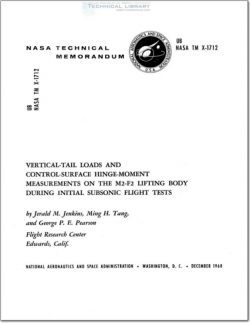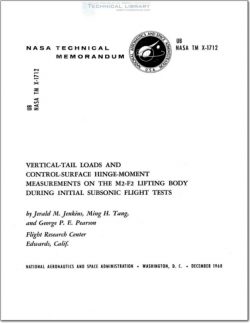NASA-TM-X-1712

- Version
- 281 Downloads
- 1.77 MB File Size
- 1 File Count
- June 15, 2016 Create Date
- June 15, 2016 Last Updated
Vertical Tail Loads and Control Surface Hinge Moment Measurements on the M2-F2 Lifting Body During Initial Subsonic Flight Tests

Subsonic aerodynamic load characteristics are presented for the right vertical tail
and the control surfaces of the M2 -F2 lifting—body vehicle. The effects of vehicle at-
titude and control-surface deflection on the vertical—tail loads are determined. Coef-
ficients defining the effects of angle of attack, angle of sideslip, upper-flap deflection,
and rudder deflection on flight-measured vertical -tail loads are presented in terms of
linear equations. Portions of two maneuver time histories are included to illustrate the
magnitude of each of these effects. The effects of angle of attack and control—surface
deflection on the flight —measured rudder, upper—flap, and lower—flap hinge moments are
discussed. The measured loads data are presented in aerodynamic —coefficient form.
Large vertical-tail loads were measured during flight tests. Flight —measured control—
surface hinge -moment data are compared with wind—tunnel data obtained from full—scale
vehicle tests.
The increasing number and scope of manned space missions has led to a need for
advanced reentry/recovery concepts. Vehicles having improved maneuvering capabili-
ties provide distinct advantages over present recovery capabilities. The lifting reentry
vehicle has increased maneuvering capability and has thus been studied (refs. 1 to 4) for
manned reentry.
One of the more important areas of investigation with this type of vehicle is low—
speed flight characteristics, inasmuch as virtually no flight-test information is avail—
able for the Wingless, short—fuselage, lifting—body configuration. Accordingly, a series
of flight tests was performed with one lifting—body configuration, designated the M2—F2.
The flight-determined lift and drag characteristics and stability and control character—
istics are presented in references 5 and 6, respectively. The M2 —F2 flight vehicle was
also tested in the 40- by 80—Foot Wind Tunnel at the NASA Ames Research Center. Re—
sults of these tests are reported in reference 7. The low-speed aerodynamic-loads data
acquired from full—scale flight tests of the M2 -F2 are presented in this report. A
knowledge of the magnitude of these aerodynamic loads is important to designers of
lifting-body vehicles, particularly since the M2 -F2 is a unique configuration.
Strain —gage instrumentation was‘use‘d toinieasure've‘r'ucai4tail loads and control—
surface hinge moments during the M2 —F2 research flights. The flight data were ob-
tained during initial unpowered glide flights; hence, the data are limited to subsonic
Mach numbers from approximately 0. 4 to 0.6.
| File | Action |
|---|---|
| NASA-TM-X-1712 Vertical Tail Loads and Control Surface Hinge Moment Measurements on the M2-F2 Lifting Body During Initial Subsonic Flight Tests.pdf | Download |
Comment On This Post